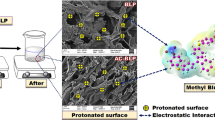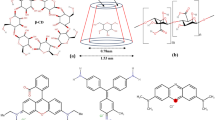Abstract
Remazol Brilliant Blue R (RBBR) is a widely used carcinogenic and toxic dye. This study focused on RBBR dye removal using chemically modified and unmodified Yarrowia lipolytica biomass. RBBR dye biosorption studies were carried out as a function of pH, initial dye concentration, biosorbent dose, contact time, and temperature. The pH of the aqueous solution strongly influenced the biosorption percent of RBBR dye. The highest dye biosorption capacity yield was obtained at pH 2–3 range. It has been found that the adsorption capacity is quite low at higher pH values. No differences were found between chemically modified and unmodified biomass in terms of RBBR dye biosorption capacity. In the first 15 min, almost 50% RBBR dye was removed from the solution and reached equilibrium within180 min at pH 2. Biosorption isotherm obeyed Langmuir isotherm model and pseudo-second-order kinetic model.





Similar content being viewed by others
References
Ada K, Ergene A, Tan S, Yalçın E (2009) Adsorption of Remazol Brilliant Blue R using ZnO fine powder: equilibrium, kinetic and thermodynamic modeling studies. J Hazard Mater 165:637–644
Ahmad MA, Herawan SG, Yusof AA (2014) Equilibrium, kinetics, and thermodynamics of Remazol Brilliant Blue R dye adsorption onto activated carbon prepared from Pinang frond. ISRN Mech Eng 2014:1–7. https://doi.org/10.1155/2014/184265
Aksu Z, Dönmez G (2003) A comparative study on the biosorption characteristics of some yeasts for Remazol Blue reactive dye. Chemosphere 50:1075–1083
Alver E, Metin AÜ (2012) Anionic dye removal from aqueous solutions using modified zeolite: adsorption kinetics and isotherm studies. Chem Eng J 200–202:59–67. https://doi.org/10.1016/j.cej.2012.06.038
Arica MY, Bayramoǧlu G (2007) Biosorption of Reactive Red-120 dye from aqueous solution by native and modified fungus biomass preparations of Lentinus sajor-caju. J Hazard Mater 149:499–507. https://doi.org/10.1016/j.jhazmat.2007.04.021
Ayub S, Mohammadi AA, Yousefi M, Changani F (2019) Performance evaluation of agro-based adsorbents for the removal of cadmium from wastewater. Desalin Water Treat. https://doi.org/10.5004/dwt.2019.23455
Bai RS, Abraham TE (2002) Studies on enhancement of Cr (VI) biosorption by chemically modified biomass of Rhizopus nigricans. Water Res 36:1224–1236
El-Naas MH, Alhaija MA (2013) Modelling of adsorption processes. In: Brenan CR (ed) Mathematical Modelling, 1st edn. Nova Publishers, New York, pp 579–600
Ergene A, Ada K, Tan S, Katircioǧlu H (2009) Removal of Remazol Brilliant Blue R dye from aqueous solutions by adsorption onto immobilized Scenedesmus quadricauda: equilibrium and kinetic modeling studies. Desalination 249:1308–1314. https://doi.org/10.1016/j.desal.2009.06.027
Fan T, Liu Y, Feng B et al (2008) Biosorption of cadmium (II), zinc (II) and lead (II) by Penicillium simplicissimum: Isotherms, kinetics and thermodynamics. J Hazard Mater 160:655–661. https://doi.org/10.1016/j.jhazmat.2008.03.038
Febrianto J, Kosasih AN, Sunarso J et al (2009) Equilibrium and kinetic studies in adsorption of heavy metals using biosorbent: a summary of recent studies. J Hazard Mater 162:616–645. https://doi.org/10.1016/j.jhazmat.2008.06.042
Gad HMH, El-Sayed AA (2009) Activated carbon from agricultural by-products for the removal of Rhodamine-B from aqueous solution. J Hazard Mater 168:1070–1081. https://doi.org/10.1016/j.jhazmat.2009.02.155
Gonçalves FAG, Colen G, Takahashi JA (2014) Yarrowia lipolytica and its multiple applications in the biotechnological industry. Sci World J. https://doi.org/10.1155/2014/476207
Gong R, Sun Y, Chen J et al (2005) Effect of chemical modification on dye adsorption capacity of peanut hull. Dyes Pigments 67:175–181. https://doi.org/10.1016/j.dyepig.2004.12.003
Hasan Z, Jeon J, Jhung SH (2012) Adsorptive removal of naproxen and clofibric acid from water using metal-organic frameworks. J Hazard Mater 209–210:151–157. https://doi.org/10.1016/j.jhazmat.2012.01.005
Ho YS, McKay G (1999) Pseudo-second order model for sorption processes. Process Biochem 34:451–465. https://doi.org/10.1016/S0032-9592(98)00112-5
Huang J, Liu D, Lu J et al (2016) Colloids and surfaces a: physicochemical and engineering aspects Biosorption of reactive black 5 by modified Aspergillus versicolor biomass: kinetics, capacity and mechanism studies. Colloids Surf Physicochem Eng Asp 492:242–248. https://doi.org/10.1016/j.colsurfa.2015.11.071
Hussain S, Kamran M, Khan SA et al (2021) Adsorption, kinetics and thermodynamics studies of methyl orange dye sequestration through chitosan composites films. Int J Biol Macromol 168:383–394. https://doi.org/10.1016/j.ijbiomac.2020.12.054
Jeon C, Park JY, Yoo YJ (2002) Characteristics of metal removal using carboxylated alginic acid. Water Res 36:1814–1824. https://doi.org/10.1016/S0043-1354(01)00389-X
Jianlong W (2002) Biosorption of copper (II) by chemically modified biomass of Saccharomyces cereisiae. Process Biochem 37:847–850
Jung C, Park J, Lim KH et al (2013) Adsorption of selected endocrine disrupting compounds and pharmaceuticals on activated biochars. J Hazard Mater. https://doi.org/10.1016/j.jhazmat.2013.10.033
Kumar NS, Min K (2011) Phenolic compounds biosorption onto Schizophyllum commune fungus: FTIR analysis, kinetics and adsorption isotherms modeling. Chem Eng J 168:562–571. https://doi.org/10.1016/j.cej.2011.01.023
Kumar KV, Ramamurthi V, Sivanesan S (2006) Biosorption of malachite green, a cationic dye onto Pithophora sp., a fresh water algae. Dyes Pigm 69:102–107. https://doi.org/10.1016/j.dyepig.2005.02.005
Lagergren S (1898) About the theory of so-called adsorption of solid substance. Handlinger. https://doi.org/10.4236/ss.2014.52008calledadsorptionofsolidsubstance
Liu K, Li H, Wang Y et al (2015) Adsorption and removal of rhodamine B from aqueous solution by tannic acid functionalized graphene. Colloids Surf Physicochem Eng Asp 477:35–41. https://doi.org/10.1016/j.colsurfa.2015.03.048
Luo F (2006) Biosorption of lead ion by chemically modified biomass of marine brown algae. Laminaria Japonica 64:1122–1127. https://doi.org/10.1016/j.chemosphere.2005.11.076
Mafra MR, Igarashi-Mafra L, Zuim DR et al (2013) Adsorption of remazol brilliant blue on an orange peel adsorbent. Braz J Chem Eng 30:657–665. https://doi.org/10.1590/S0104-66322013000300022
Mate CJ, Mishra S (2020) Synthesis of borax cross-linked Jhingan gum hydrogel for remediation of Remazol Brilliant Blue R (RBBR) dye from water: adsorption isotherm, kinetic, thermodynamic and biodegradation studies. Int J Biol Macromol 151:677–690. https://doi.org/10.1016/j.ijbiomac.2020.02.192
Mohamed SH, El-Gendy AA, Abdel-Kader AH, El-Ashkar EA (2015) Removal of heavy metals from water by adsorption on chitin derivatives. Der Pharma Chemica 7:275–283
Novotnýeněk RB, Bhatt M et al (2001) Capacity of Irpex lacteus and Pleurotus ostreatus for decolorization of chemically different dyes. J Biotechnol 89:113–122. https://doi.org/10.1016/S0168-1656(01)00321-2
Rao JR, Viraraghavan T (2002) Biosorption of phenol from an aqueous solution by Aspergillus niger biomass. Bioresour Technol 85:165–171. https://doi.org/10.1016/S0960-8524(02)00079-2
Ratnamala GM, Shetty KV, Srinikethan G (2012) Removal of remazol brilliant blue dye from dye-contaminated water by adsorption using red mud: equilibrium, kinetic, and thermodynamic studies. Water Air Soil Pollut 223:6187–6199. https://doi.org/10.1007/s11270-012-1349-4
Salvi NA, Chattopadhyay S (2016) Biosorption of Azo dyes by spent Rhizopus arrhizus biomass. Appl Water Sci. https://doi.org/10.1007/s13201-016-0417-0
Saratale GD, Chang J (2011) Bacterial decolorization and degradation of Azo dyes: a review. J Taiwan Inst Chem Eng 42:138–157. https://doi.org/10.1016/j.jtice.2010.06.006
Saroyda JRV, Cruz RYS, Antonio RJC, et al (2020) PUPAIM: a collection of physical and chemical adsorption isotherm models. Version 0.2.0URL https://CRAN.R-project.org/package=PUPAIM
Silva TL, Ronix A, Pezoti O et al (2016) Mesoporous activated carbon from industrial laundry sewage sludge: adsorption studies of reactive dye Remazol Brilliant Blue R. Chem Eng J 303:467–476. https://doi.org/10.1016/j.cej.2016.06.009
Silverstein RM, Webster XF KJD (2005) Spectrometric identification of organic compounds 7th edn. Wiley, New Jersey
Sun XF, Wang SG, Cheng W et al (2011) Enhancement of acidic dye biosorption capacity on poly(ethylenimine) grafted anaerobic granular sludge. J Hazard Mater 189:27–33. https://doi.org/10.1016/j.jhazmat.2011.01.028
Trivedi KN, Boricha AB, Bajaj HC, Jasra RV (2009) Adsorption of Remazol Brilliant Blue R dye from water by polyaluminum chloride. Rasayan J Chem 2:379–385
Xiong XJ, Meng XJ, Zheng TL (2010) Biosorption of C.I. Direct Blue 199 from aqueous solution by nonviable Aspergillus niger. J Hazard Mater 175:241–246. https://doi.org/10.1016/j.jhazmat.2009.09.155
Yagub MT, Sen TK, Afroze S, Ang HM (2014) Dye and its removal from aqueous solution by adsorption: a review. Adv Colloid Interface Sci 209:172–184. https://doi.org/10.1016/j.cis.2014.04.002
Zheng Y, Cheng B, Fan J et al (2021) Review on nickel-based adsorption materials for Congo red. J Hazard Mater 403:123–559. https://doi.org/10.1016/j.jhazmat.2020.123559
Author information
Authors and Affiliations
Corresponding author
Additional information
Communicated by Yusuf Akhter.
Publisher's Note
Springer Nature remains neutral with regard to jurisdictional claims in published maps and institutional affiliations.
Supplementary Information
Below is the link to the electronic supplementary material.
Rights and permissions
About this article
Cite this article
Aracagök, Y.D. Biosorption of Remazol Brilliant Blue R dye onto chemically modified and unmodified Yarrowia lipolytica biomass. Arch Microbiol 204, 128 (2022). https://doi.org/10.1007/s00203-021-02743-3
Received:
Revised:
Accepted:
Published:
DOI: https://doi.org/10.1007/s00203-021-02743-3




